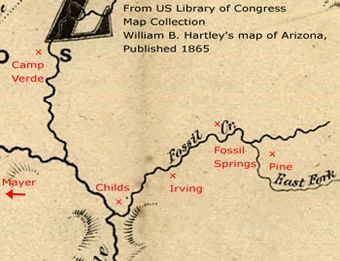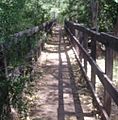Childs-Irving Hydroelectric Facilities facts for kids
Quick facts for kids |
|
|
Childs-Irving Hydroelectric Facilities
|
|

A map showing the locations of Fossil Creek and the Childs-Irving power plants
|
|
| Location | Yavapai and Gila counties, Arizona, United States |
|---|---|
| Nearest city | Camp Verde, Arizona |
| Built | 1909 |
| NRHP reference No. | 91001023 |
| Added to NRHP | August 9, 1991 |
The Childs-Irving Hydroelectric Facilities were two power plants built in the early 1900s. They used the flowing water of Fossil Creek in Arizona to create electricity. These facilities included the power plants, a dam, and other structures.
In 1971, the complex was recognized as a Historic Mechanical Engineering Landmark. It was also added to the National Register of Historic Places in 1991. The plants stopped making electricity in 2005. Since then, many parts of the facilities, like the dam and the Irving Power Plant, have been removed. The goal was to let Fossil Creek flow naturally again.
Contents
How the Power Plants Were Built
Planning for Power in Arizona
In 1900, a rancher named Lew Turner bought the rights to use the water from Fossil Creek. This creek flows from the Mogollon Rim down to the Verde River. Turner wanted to use the creek's water to make hydroelectric power. This is electricity made from moving water. He planned to sell this power to mining towns in Yavapai County, like Jerome.
Building the Childs Plant
The Arizona Power Company started building the Childs Power Plant in 1908. This company later became part of Arizona Public Service Company (APS). Building the plant was very hard because the area around Fossil Creek has many mountains and deep canyons. The closest train station was in Mayer, about 40 miles (64 km) away.
To get materials to the site, over 400 mules and 600 men were needed. They pulled more than 150 wagons along the rough trail. Many of the workers were Apache and Mojave Native Americans. They built a dam, a powerhouse, and long concrete channels called flumes. These flumes carried water to the Childs plant, which was located near where Fossil Creek meets the Verde River.
Adding the Irving Plant
The Irving plant was built later, between 1915 and 1916. It was located along Fossil Creek, between the Childs plant and Fossil Springs. The area was perfect for a power plant because of its canyons and steep drops. The springs provided a steady flow of water, about 43 cubic feet (1.2 cubic meters) per second. Once both plants were finished, they could produce 4.2 megawatts of electricity together.
Naming the Facilities
The Arizona Power Company got money to build the Childs plant from a company called William Bonbright and Company. The plant was named after S. W. Childs, who helped sell the investment bonds for the Bonbright Company. The Irving plant was named after Irving Bonbright, one of the company's founders. A reservoir, or artificial lake, called Stehr Lake was named after Frederick W. Stehr. He was the treasurer of the Arizona Power Company.
Recognizing Their Importance
The American Society of Mechanical Engineers recognized Childs-Irving as an Historic Mechanical Engineering Landmark in 1976. This means it was an important example of engineering history. In 1991, the facilities were also added to the National Register of Historic Places.
Closing the Plants
In 2005, APS decided to close both power plants. They looked at the costs and how little electricity the plants were making. They also wanted to help restore Fossil Creek to its natural state. In 2008, APS removed the dam, the flumes, and the access roads. They also planted native plants near where the dam used to be. This helped the creek flow freely again.
Flumes and Tunnels for Water Flow
The first part of building the power plants involved creating concrete flumes and tunnels. These structures were essential for guiding the water from Fossil Creek to the power plants. They made sure the water flowed at the right speed and in the right direction to generate electricity.
Stehr Lake: A Water Storage Area
Between the Irving and Childs plants, the water from the flumes flowed into an artificial lake called Stehr Lake. This lake was very important. It acted as a backup water supply for the Childs plant. If the flume system above the lake needed to be shut down for repairs, Stehr Lake could hold enough water to keep the Childs plant running for about 3.5 days.
Why "Fossil" Creek?
Fossil Springs and Fossil Creek got their names because of something special in the water. The water contains a lot of calcium carbonate. This mineral causes bone-like deposits, called travertine, to form in and around the creek bed. These deposits look a bit like fossils, giving the creek its unique name.
Images for kids















